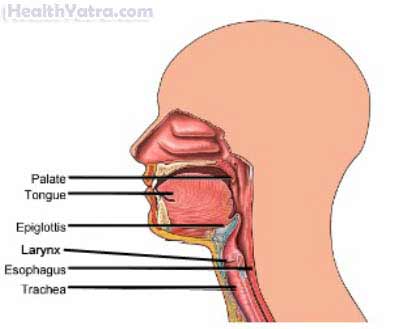Definition
Epiglottitis is severe swelling of the epiglottis. The epiglottis is a flap-like tissue located in the throat. During swallowing, the epiglottis folds over the windpipe and vocal chords to prevent food and liquids from entering the lungs. Swelling can quickly seal off a person’s airway and make breathing difficult.
Epiglottitis is rare and requires immediate medical attention. If you think you, your child, or someone you know has epiglottitis, go to the emergency room right away.

Causes
Factors that can cause epiglottitis include:
- Bacteria, viruses, and fungi , such as:
- Haemophilus influenzae type b (Hib)—the most common cause and the cause of the most deadly type of epiglottitis; not the same germ that causes the flu
- Staphylococcus aureus —also the cause of skin infections, pneumonia, and blood infections
- Streptococcus pneumoniae —also the cause of meningitis and pneumonia
- Streptococcus A, B, and C—also the cause of strep throat and blood infections
- Candida albicans —also the cause of yeast infections, diaper rash, and oral thrush
- Varicella zoster —also the cause of chickenpox and shingles
- Burns from hot liquids
- Physical injury to the throat area
- Crack cocaine
Risk Factors
Epiglottitis spreads easily. It is passed much like the common cold, through droplets released when sneezing and coughing. Anyone can develop epiglottitis. The following factors can increase a person’s risk:
- Age:
- Children, aged 3-7, living in countries that do not offer vaccines
- Infants younger than two months who are too young to receive vaccination
- Rarely, adults in their 40s
- Sex: Male
- Living in close quarters
- Attending day care, being in school, or working in an office
- Weather: more common in winter
- Race: more common among African Americans and Hispanics
Symptoms
Epiglottitis is a rare disease. If you or your child experiences any of these symptoms, do not assume it is due to epiglottitis. These symptoms may be caused by other, less serious health conditions.
- Cough
- Fever over 103°F
- Sore throat and severe throat pain
- Difficulty swallowing with drooling
- Muffled voice
- Breathing problems:
- Rapid breathing
- Increasingly difficult breathing
- Leaning forward and arching the neck backward to breathe
- Squeaky or raspy sounds while inhaling, caused by airway blockage
- Symptoms associated with low oxygen levels:
- Bluish tint to skin or lips
- Sluggishness
- Confusion
- Irritability
Symptoms appear suddenly and worsen quickly.
Note: Do not attempt to use a tongue depressor or any other utensil to look into the person’s throat. A throat spasm could occur and cause the airway to close completely.
Diagnosis
When you arrive at the hospital, the doctor will first make sure you are able to breathe. After this is known, the doctor will ask about your symptoms and medical history. If you are not having trouble breathing, the doctor may use a mirror to look down your throat.
You may have the following tests done:
- Your doctor may test your bodily fluids and cells. This can be done with:
- Blood culture and count
- Throat culture
- Your doctor may need to view your bodily structures. This can be done with:
- Nasolaryngoscopy
- Neck x-ray
Treatment
The doctor will first stabilize your airway and then give proper medication depending on the cause. You may also have other illnesses that need to be treated depending on the cause of the epiglottitis such as blood infections due to Streptococcus.
If you CAN breathe, you will be closely monitored in the intensive care unit.
If you CANNOT breathe, the options include:
- Endotracheal intubation—A breathing tube is inserted through the nose or mouth and fed into the airway. This can only be done if the airway is not swollen shut. It should be done by an experienced physician.
- Tracheotomy —A breathing tube is inserted directly into the airway. This is done if the airway is swollen shut or if the airway is too swollen to do an endotracheal intubation.
After the airway is stabilized, you will be monitored and started on IV antibiotics. Antibiotics help kill the organism causing the infection and swelling. At first, a variety of antibiotics may be given if the identity of the germ is not yet known. After the laboratory test results are known, a specific antibiotic can be given.
After swelling decreases, the breathing tube can be removed. Usually, there are not any lasting side effects of epiglottitis, and the outlook is good.
If you are diagnosed with epiglottitis, follow your doctor’s instructions .
Prevention
Vaccination with the Hib vaccine is the only way to prevent epiglottitis. Currently, infants born in the US are given one of these vaccines at two months of age. Since vaccination began, adults have been at even lower risk of developing epiglottitis. If you have a weak immune system or are on medications that may make you more prone to illness, speak with your doctor about getting vaccinated.
An preventive antibiotic may be prescribed for:
- Household members and others who have spent time in the previous five out of seven days with an affected individual
- All daycare staff
